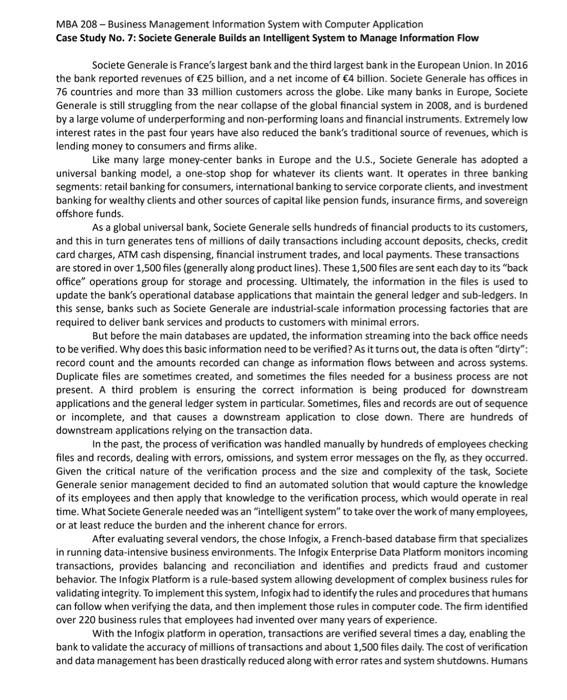MBA 208 - Business Management Information System with Computer Application Case Study No. 7: Societe Generale Builds an Intelligent System to Manage Information Flow Societe Generale is France's largest bank and the third largest bank in the European Union. In 2016 the bank reported revenues of 25 billion, and a net income of 4 billion. Societe Generale has offices in 76 countries and more than 33 million customers across the globe. Like many banks in Europe, Societe Generale is still struggling from the near collapse of the global financial system in 2008, and is burdened by a large volume of underperforming and non-performing loans and financial instruments. Extremely low interest rates in the past four years have also reduced the bank's traditional source of revenues, which is lending money to consumers and firms alike. Like many large money-center banks in Europe and the U.S., Societe Generale has adopted a universal banking model, a one-stop shop for whatever its clients want. It operates in three banking segments: retail banking for consumers, international banking to service corporate clients, and investment banking for wealthy clients and other sources of capital like pension funds, insurance firms, and sovereign offshore funds. As a global universal bank, Societe Generale sells hundreds of financial products to its customers, and this in turn generates tens of millions of daily transactions including account deposits, checks, credit card charges, ATM cash dispensing, financial instrument trades, and local payments. These transactions are stored in over 1,500 files (generally along product lines). These 1,500 files are sent each day to its "back office" operations group for storage and processing. Ultimately, the information in the files is used to update the bank's operational database applications that maintain the general ledger and sub-ledgers. In this sense, banks such as Societe Generale are industrial-scale information processing factories that are required to deliver bank services and products to customers with minimal errors. But before the main databases are updated, the information streaming into the back office needs to be verified. Why does this basic information need to be verified? As it turns out, the data is often "dirty": record count and the amounts recorded can change as information flows between and across systems. Duplicate files are sometimes created, and sometimes the files needed for a business process are not present. A third problem is ensuring the correct information is being produced for downstream applications and the general ledger system in particular. Sometimes, files and records are out of sequence or incomplete, and that causes a downstream application to close down. There are hundreds of downstream applications relying on the transaction data. In the past, the process of verification was handled manually by hundreds of employees checking files and records, dealing with errors, omissions, and system error messages on the fly, as they occurred. Given the critical nature of the verification process and the size and complexity of the task, Societe Generale senior management decided to find an automated solution that would capture the knowledge of its employees and then apply that knowledge to the verification process, which would operate in real time. What Societe Generale needed was an "intelligent system" to take over the work of many employees, or at least reduce the burden and the inherent chance for errors. After evaluating several vendors, the chose Infogix, a French-based database firm that specializes in running data-intensive business environments. The Infogix Enterprise Data Platform monitors incoming transactions, provides balancing and reconciliation and identifies and predicts fraud and customer behavior. The Infogix Platform is a rule-based system allowing development of complex business rules for validating integrity. To implement this system, Infogix had to identify the rules and procedures that humans can follow when verifying the data, and then implement those rules in computer code. The firm identified over 220 business rules that employees had invented over many years of experience. With the Infogix platform in operation, transactions are verified several times a day, enabling the bank to validate the accuracy of millions of transactions and about 1,500 files daily. The cost of verification and data management has been drastically reduced along with error rates and system shutdowns. Humans 3. What is the role of human decision makers in the new system? 4. Why did managers select the Infogix platform








